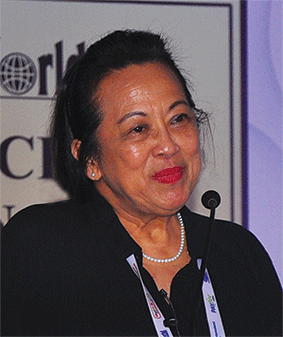KEYNOTE ADDRESS: NAN CIVEL
Dr. Maria Montessori’s legacy
 Awareness of the vital importance of early childhood care and education (ECCE) dawned upon me rather late in life. My working life started with Unilever Malaysia in the human resources department. During a ten-year journey from internship to management, I met many disagreeable adults and happiness became elusive. Therefore I decided to start over and work with children instead.
Awareness of the vital importance of early childhood care and education (ECCE) dawned upon me rather late in life. My working life started with Unilever Malaysia in the human resources department. During a ten-year journey from internship to management, I met many disagreeable adults and happiness became elusive. Therefore I decided to start over and work with children instead.
That’s when I began to learn about this remarkable woman — a doctor, anthropologist, psychologist and educationist — who in the late 19th century, researched and developed her unique pedagogy to educate youngest children to build them strong foundations for further study and personal growth and development.
Forty years of Dr. Maria Montessori’s life were devoted to pre-primary education. Her books and lectures highlighted that there is a remarkable force in every human being, and this force, which she termed as energy from the psychic embryo, is at its most powerful during the first phase of human development — from 0-6 years of age. In the second phase of childhood, this force stabilises and in the adolescent third phase, it weakens and often runs awry with several research studies linking anti-social behaviour of adolescents to deficient ECCE during the infant phase.
All children from birth have an inherent quality which she described as the “absorbent mind”. A child’s mind can rapidly assimilate languages, religion, customs and the peculiarities of the environment she grows in. This magical mind can absorb all elements, good or damaging. Some contemporary neuroscientists have described the brain of a child as a social organ. It weighs a mere 1.4 kg but thrives on communication and experiences which ignite the connections of the neurons or synapses.
Research has also revealed that a child from an educated family can learn more than 1,500 words by the time she is three years of age, provided she hears double the number of words. Moreover, children can learn a second language with ease. On the other hand, children from educationally deprived families learn and grasp only 50-100 words because they are likely to hear only 100-200 words of adults. “Childhood constructs with what it finds. If the material is poor, the construction is poor,” observed Dr. Montessori.
In 1908, Dr. Montessori started her first classroom for 60 underprivileged children aged 2.5-6 in San Lorenzo, a poor neighbourhood of Rome and christened it the Casa De Bambini (Children’s House). This model classroom, known today as The Prepared Environment, was equipped with furniture, fittings and learning materials scaled down to child size, and teaching material was divided into five curriculum areas. It was in this setting that she discerned the true nature of children.
Dr. Montessori conducted her first experiments in the Casa and closely observed how children responded to her prepared environment. She noted that they thrived in free but orderly environments which set limits and systems. In a short time, children began to work with concentration and experienced a radical transformation with the shy becoming communicative and uncoordinated children learning to balance their materials as they learned cooperatively and harmoniously in groups.
The process of ‘normalisation’ was noticeable in this classroom. Dr. Montessori drew this word from anthropology because it was her conviction that placing children in prepared environments allows their sociable inner selves to bloom. In her opinion, normalisation transforms children into contributing members of their societies. The transformation begins when children become deeply immersed in purposeful activities, develop concentration and acquire love of learning. In conducive environments, they become independent, self-disciplined, responsible, happy and sociable. Character-building goes hand in hand with intellectual development.
In prepared classrooms, the educator is the directress — the dynamic link between children and the environment. Her goal is to prepare children for self-regulation and learning. She has to transform her own persona, shed her prejudices and direct her pupils’ inherent energy towards purposeful activities. She is warm and encouraging and supports children learning in their own style and speed. In short, the directress transforms herself into a compassionate role model. In her lifetime, Dr. Montessori motivated many women to fit this role.
Compassionate children with caring, respectful qualities build a positive self-image which provides them a good start in primary school. However, Dr. Montessori’s educational objectives went far beyond school preparedness. She was confident children with positive self-images would become ethical and humane adults who will lead the world towards peace and harmony. Dr. Montessori herself lived through the two World Wars of the 20th century. Some of her schools in Italy were closed by the disagreeable dictator Benito Mussolini and she was banished from the country. She recovered emotionally right here in this country in Chennai, thanks to caring people who respected her work.
Learning from her experience, we must never lose hope. If we believe education is for peace, our role in nurturing the youngest citizens of the world is very important.
(Nan Civil is founder of The Children’s House, a group of preschools in Malaysia)























